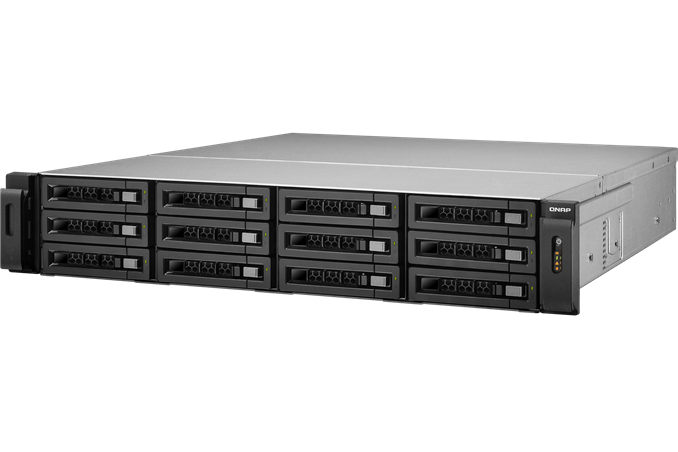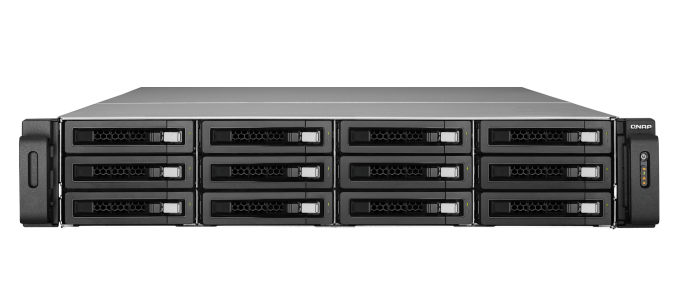QNAP's TS-EC1279U-RP 12-bay Flagship Rackmount NAS Review
by Ganesh T S on April 29, 2013 4:30 PM EST- Posted in
- Enterprise
- Storage
- NAS
- QNAP

Introduction
Our enterprise NAS reviews have focused on Atom-based desktop form factor systems till now. These units have enough performance for a moderately sized workgroup and lack some of the essential features in the enterprise space such as acceptable performance with encrypted volumes. A number of readers have mailed in asking for more coverage of the NAS market straddling the high-end NAS and the NAS - SAN (storage area network) hybrid space. Models catering to this space come in the rackmount form factor and are based on more powerful processors such as the Core series or the Xeon series.
QNAP's 12-bay flagship unit is the TS-EC1279U-RP. Based on the Xeon E3-1225 processor, this 2U rackmount system comes with twelve hot-swappable bays and 4GB of ECC RAM. Both SATA and SAS disks in 3.5" as well as 2.5" form factor are supported.
The last QNAP unit that we reviewed was the TS-659 Pro II. Around that time, QNAP was struggling with some data corruption issues in their firmware. We were hesitant to carry on reviewing QNAP's products while this issue remained outstanding. The solution came in the form of FW release v3.7.1 almost a year after the problem was first reported. We have been using a couple of QNAP units in-house with later firmware releases and couldn't replicate the bug in our environment. This gave us enough confidence to request QNAP for one of their latest NAS units. They obliged with the TS-1279U-RP, and it also marks our foray into reviewing units in the rackmount space.
The specifications of the TS-EC1279U-RP are as below:
| QNAP TS-EC1279U-RP Specifications | |
| Processor | Intel Xeon E3-1225 (4C, 3.1 GHz) |
| RAM | 4 GB DDR3 ECC RAM (Upgradable to 8 GB) |
| Flash | 512MB DOM |
| Drive Bays | 12x 3.5"/2.5" SATA / SAS 6 Gbps HDD / SSD |
| Network Links | 4x 1 GbE (Two links upgradable to 10 GbE) |
| USB Slots | 2x USB 3.0 / 4x USB 2.0 |
| eSATA Slots | 2x |
| Expansion Slots | 2x (Network or Storage Expansion) |
| VGA | Reserved for Maintenance |
| Full Specifications Link | QNAP TS-EC1279U-RP Hardware Specs |
In the rest of the review, I will cover some unboxing and setup impressions. A detailed description of the testbed setup and testing methodology is followed by performance numbers in both single and multi-client modes. As requested by multiple readers, we will also briefly cover performance with encryption enabled. In the final section, power consumption numbers as well as RAID rebuild times will be covered along with some closing notes.











23 Comments
View All Comments
Evadman - Wednesday, May 1, 2013 - link
Why is this so expensive for the performance, and why is single client performance so bad? Granted I deal with actual enterpise class SAN devices from EMC and the like, but even my ~4 year old personal server can beat this box. My crappy home server is a 20 rotational Hitachi 3 TB GST Deskstar 0S03230 disks in RAID 60, a E5200 CPU and an Adaptec 52445 running on MS Server 2008, not even close to being decent for enterprise level. Besides the disks, it cost under a grand and will max out a quadlinked 4gbps connection with one client, I don't need to add 3 or 4 as your graphs show that this box needs. There is no excuse for a 20 rotational disk device to beat this 12 disk SSD NAS/SAN before hitting the network limit. I should get a dozen SSD's and a 10 gig switch and see what my crappy box can do just for kicks. *makes notes to see if a spare switch can be found in the office*ganeshts - Wednesday, May 1, 2013 - link
The single client performance is for a single client with a 1 GbE link (so it can't max out a 4GbE link obviously). Client machines usually have only a single GbE port.Our multi-client graphs show performance with multiple clients and indicate limitation because of the network link bandwidth on the NAS side
Evadman - Thursday, May 2, 2013 - link
I must be misreading the graphs being presented then. This real world graph: http://images.anandtech.com/doci/6922/qnap_ts1279u... shows 5 clients, each at ~20MB/s for a total of 80 MB/s. Theoretical maximum is 125 MB/s, Adding the control data to the payload of the frame, and you should have about 97.5% data. So it looks like it taking more than 5 clients to get to the 1gbps limit. On the single client CIFS graph here: http://images.anandtech.com/graphs/graph6922/54437... only 2 of the performance benchmarks appear network limited at 123 MB/s. Office Productivity is low at 25-28 MB/s, as that is probably what a small business is going to be doing the most of. Is this a client/CIFS issue and not a NAS/SAN issue?